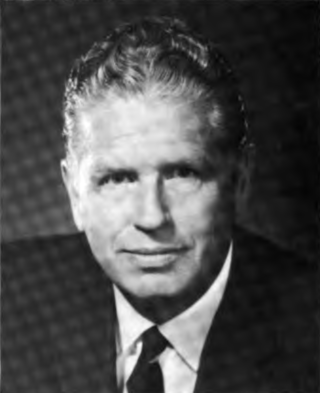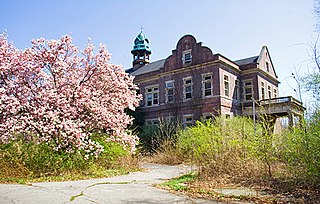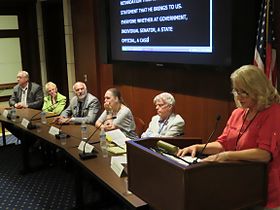
The Eleventh Amendment is an amendment to the United States Constitution which was passed by Congress on March 4, 1794, and ratified by the states on February 7, 1795. The Eleventh Amendment restricts the ability of individuals to bring suit against states of which they are not citizens in federal court.
Board of Trustees of the University of Alabama v. Garrett, 531 U.S. 356 (2001), was a United States Supreme Court case about Congress's enforcement powers under the Fourteenth Amendment to the United States Constitution. The Supreme Court decided that Title I of the Americans with Disabilities Act was unconstitutional, insofar as it allowed states to be sued by private citizens for money damages.

The Education for All Handicapped Children Act was enacted by the United States Congress in 1975. This act required all public schools accepting federal funds to provide equal access to education and one free meal a day for children with physical and mental disabilities. Public schools were required to evaluate children with disabilities and create an educational plan with parent input that would emulate as closely as possible the educational experience of non-disabled students. The act was an amendment to Part B of the Education of the Handicapped Act enacted in 1966.

The Baby Doe Law or Baby Doe Amendment is an amendment to the Child Abuse Prevention and Treatment Act of 1974, passed in 1984, that sets forth specific criteria and guidelines for the treatment of disabled newborns in the United States, regardless of the wishes of the parents.
Self-advocacy is the act of speaking up for oneself and one's interests. It is used as a name for civil rights movements and mutual aid networks for people with intellectual and developmental disabilities. The term arose in the broader civil rights movements of the 1960s and 1970s, and is part of the disability rights movement. Today there are self-advocacy organizations across the world.

Raymond Joseph "Ray" Broderick was an American jurist and politician from the Commonwealth of Pennsylvania. A member of the Republican Party, he served as the 24th lieutenant governor of Pennsylvania from 1967 to 1971 and as a United States district judge of the United States District Court for the Eastern District of Pennsylvania.
Youngberg v. Romeo, 457 U.S. 307 (1982), was a landmark United States Supreme Court case regarding the rights of the involuntarily committed and those with intellectual disabilities. Nicholas Romeo had an intellectual disability with an infant level IQ and was committed to a Pennsylvania state hospital. He was restrained for 9 months straight out of his 11 month stay and repeatedly abused. The Supreme Court agreed with the Third Circuit Court of Appeals that involuntarily committed residents had the right to reasonably safe confinement conditions, no unreasonable body restraints and the habilitation they reasonably require.

Pennhurst State School and Hospital, originally known as the Eastern Pennsylvania State Institution for the Feeble-Minded and Epileptic was a state-run institution for mentally and physically disabled individuals of Southeastern Pennsylvania located in Spring City. After 79 years of controversy, it closed on December 9, 1987.
Olmstead v. L.C., 527 U.S. 581 (1999), is a United States Supreme Court case regarding discrimination against people with intellectual disabilities. The Supreme Court held that under the Americans with Disabilities Act, individuals with intellectual disabilities have the right to live in the community rather than in institutions if, in the words of the opinion of the Court, "the State's treatment professionals have determined that community placement is appropriate, the transfer from institutional care to a less restrictive setting is not opposed by the affected individual, and the placement can be reasonably accommodated, taking into account the resources available to the State and the needs of others with mental disabilities." The case was brought by the Atlanta Legal Aid Society on behalf of Lois Curtis.
Rizzo v. Goode, 423 U.S. 362 (1976), was a United States Supreme Court case in which the Court held that a prophylactic injunction against non-culpable state executive officials was an overbroad interference by the Federal Courts in the state executive branches. In doing so, the court created a limit on the federal injunctive power in matters of state agency internal affairs.

In United States law, the federal government as well as state and tribal governments generally enjoy sovereign immunity, also known as governmental immunity, from lawsuits. Local governments in most jurisdictions enjoy immunity from some forms of suit, particularly in tort. The Foreign Sovereign Immunities Act provides foreign governments, including state-owned companies, with a related form of immunity—state immunity—that shields them from lawsuits except in relation to certain actions relating to commercial activity in the United States. The principle of sovereign immunity in US law was inherited from the English common law legal maxim rex non potest peccare, meaning "the king can do no wrong." In some situations, sovereign immunity may be waived by law.
Atascadero State Hospital v. Scanlon, 473 U.S. 234 (1985), was a United States Supreme Court case regarding Congress' power to abrogate the Eleventh Amendment sovereign immunity of the states.
United States v. Georgia, 546 U.S. 151 (2006), was a United States Supreme Court case in which the Court decided that the protection of Americans with Disabilities Act of 1990 (ADA), passed by the U.S. Congress, extends to persons held in a state prison and protects prison inmates from discrimination on the basis of disability by prison personnel. Specifically, the court held that Title II of the Americans with Disabilities Act of 1990, 42 U.S.C. §§ 12131–12165., is a proper use of Congressional power under the Fourteenth Amendment, Section 5, making it applicable to prison system officials.
This disability rights timeline lists events relating to the civil rights of people with disabilities in the United States of America, including court decisions, the passage of legislation, activists' actions, significant abuses of people with disabilities, and the founding of various organizations. Although the disability rights movement itself began in the 1960s, advocacy for the rights of people with disabilities started much earlier and continues to the present.
Community integration, while diversely defined, is a term encompassing the full participation of all people in community life. It has specifically referred to the integration of people with disabilities into US society from the local to the national level, and for decades was a defining agenda in countries such as Great Britain. Throughout recent decades, community integration programs have been increasingly effective in improving healthcare access for people with disabilities. They have been valued for providing a "voice for the voiceless"
Since the passage of the Affordable Care Act (ACA), there have been numerous actions in federal courts to challenge the constitutionality of the legislation. They include challenges by states against the ACA, reactions from legal experts with respect to its constitutionality, several federal court rulings on the ACA's constitutionality, the final ruling on the constitutionality of the legislation by the U.S. Supreme Court in National Federation of Independent Business v. Sebelius, and notable subsequent lawsuits challenging the ACA. The Supreme Court upheld ACA for a third time in a June 2021 decision.
Sterilization law is the area of law, within reproductive rights, that gives a person the right to choose or refuse reproductive sterilization and governs when the government may limit this fundamental right. Sterilization law includes federal and state constitutional law, statutory law, administrative law, and common law. This article primarily focuses on laws concerning compulsory sterilization that have not been repealed or abrogated and are still good laws, in whole or in part, in each jurisdiction.

Roland Johnson was an advocate for the rights of people with disabilities and one of the founders of Self Advocates Becoming Empowered (SABE). He spent 13 years institutionalized at Pennhurst State School and Hospital, until he was released in 1971 following the civil rights case, Halderman v. Pennhurst State School and Hospital.
The United States has experienced two waves of deinstitutionalization, the process of replacing long-stay psychiatric hospitals with less isolated community mental health services for those diagnosed with a mental disorder or developmental disability.

Thomas K. Gilhool was an American civil rights attorney. Noted as an advocate for the rights of people with disabilities, he served as the chief counsel for the Public Interest Law Center in Philadelphia from 1975 until 2000.








